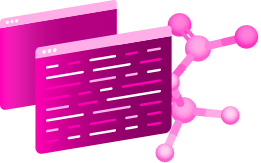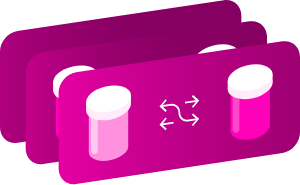Identification
- Summary
-
Trospiumis an antimuscarinic agent used to treat the symptoms of overactive bladder (OAB).
- Brand Names
-
Trosec
- Generic Name
- Trospium
- DrugBank Accession Number
- DB00209
- Background
-
Trospium is an antispasmodic agent used to treat the symptoms of overactive bladder, a condition that causes the bladder muscles to contract uncontrollably.1An overactive bladder leads to an increased urge to urinate, frequent urination, and sometimes, loss of control over urination.1Trospium is manufactured byIndevus Pharmaceutical Inc.and was granted FDA approval in 2007.2
- Type
- Small Molecule
- Groups
- Approved
- Structure
- Weight
-
Average: 392.518
Monoisotopic: 392.22202025 - Chemical Formula
- C25H30NO3
- Synonyms
- Not Available
Pharmacology
- Indication
-
For the treatment of overactive bladder with symptoms of urge urinary incontinence, urgency, and urinary frequency, detrusor instability and frequency of micturition.
 Reduce drug development failure ratesBuild, train, & validate machine-learning models
Reduce drug development failure ratesBuild, train, & validate machine-learning models
with evidence-based and structured datasets.Build, train, & validate predictive machine-learning models with structured datasets. - Associated Conditions
- Contraindications & Blackbox Warnings
-
 Avoid life-threatening adverse drug eventsImprove clinical decision support with information oncontraindications & blackbox warnings, population restrictions, harmful risks, & more.Avoid life-threatening adverse drug events & improve clinical decision support.
Avoid life-threatening adverse drug eventsImprove clinical decision support with information oncontraindications & blackbox warnings, population restrictions, harmful risks, & more.Avoid life-threatening adverse drug events & improve clinical decision support. - Pharmacodynamics
-
Trospium is an antispasmodic, antimuscarinic agent indicated for the treatment of overactive bladder with symptoms of urge urinary incontinence, urgency, and urinary frequency. According to receptor assays, it displays higher affinity towards muscarininc receptors compared to nicotinic receptors at therapeutic concentrations.
- Mechanism of action
-
Trospium antagonizes the effect of acetylcholine on muscarinic receptors in cholinergically innervated organs. Its parasympatholytic action reduces the tonus of smooth muscle in the bladder.
Target Actions Organism UMuscarinic acetylcholine receptor M3 Not Available Humans UMuscarinic acetylcholine receptor M1 antagonistHumans - Absorption
-
9.6%
- Volume of distribution
-
- 395 ± 140 L
- Protein binding
-
50-85%
- Metabolism
-
Not fully defined
- Route of elimination
-
经过政府的口头14 c-trospium氯, the majority of the dose (85.2%) was recovered in feces and a smaller amount (5.8% of the dose) was recovered in urine; 60% of the radioactivity excreted in urine was unchanged trospium. Trospium mainly undergoes elimination via active tubular secretion, as indicated by the mean renal clearance of 29.07 L/hour, which is about 4-fold higher than average glomerular filtration rate. Trospium is metabolized by ester hydrolysis and excreted by the kidneys by a combination of tubular secretion and glomerular filtration.
- Half-life
-
20 hours
- Clearance
-
- Renal cl=29.07 L/hour
- Adverse Effects
-
 Improve decision support & research outcomesWith structured adverse effects data, including:blackbox warnings, adverse reactions, warning & precautions, & incidence rates.Improve decision support & research outcomes with our structured adverse effects data.
Improve decision support & research outcomesWith structured adverse effects data, including:blackbox warnings, adverse reactions, warning & precautions, & incidence rates.Improve decision support & research outcomes with our structured adverse effects data. - Toxicity
-
Not Available
- Pathways
- Not Available
- Pharmacogenomic Effects/ADRsBrowse all" title="" id="snp-actions-info" class="drug-info-popup" href="javascript:void(0);">
- Not Available
Interactions
- Drug InteractionsLearn More" title="" id="structured-interactions-info" class="drug-info-popup" href="javascript:void(0);">
-
这些信息不应该被解释the help of a healthcare provider. If you believe you are experiencing an interaction, contact a healthcare provider immediately. The absence of an interaction does not necessarily mean no interactions exist.
Drug Interaction Integrate drug-drug
interactions in your softwareAcebutolol The metabolism of Acebutolol can be decreased when combined with Trospium. Acetaminophen The metabolism of Acetaminophen can be decreased when combined with Trospium. Aclidinium The risk or severity of adverse effects can be increased when Trospium is combined with Aclidinium. Adenosine The risk or severity of Tachycardia can be increased when Trospium is combined with Adenosine. Alfentanil The risk or severity of adverse effects can be increased when Trospium is combined with Alfentanil. Alloin The therapeutic efficacy of Alloin can be decreased when used in combination with Trospium. Almotriptan The metabolism of Almotriptan can be decreased when combined with Trospium. Alogliptin The metabolism of Alogliptin can be decreased when combined with Trospium. Amantadine The risk or severity of adverse effects can be increased when Trospium is combined with Amantadine. Ambenonium The therapeutic efficacy of Trospium can be decreased when used in combination with Ambenonium.  Identify potential medication risksEasily compare up to 40 drugs with our drug interaction checker.Get severity rating, description, and management advice.Learn more
Identify potential medication risksEasily compare up to 40 drugs with our drug interaction checker.Get severity rating, description, and management advice.Learn more - Food Interactions
-
- Take on an empty stomach. Take at least 1 hour before food as the Cmax and AUC of trospium are reduced by 70-80% when taken with a high fat meal.
Products
-
 Drug product information from 10+ global regionsOur datasets provide approved product information including:
Drug product information from 10+ global regionsOur datasets provide approved product information including:
dosage, form, labeller, route of administration, and marketing period.Access drug product information from over 10 global regions. - Product Ingredients
-
Ingredient UNII CAS InChI Key Trospium chloride 1E6682427E 10405-02-4 RVCSYOQWLPPAOA-QKYUOBHYSA-M - Product Images
-
- International/Other Brands
- Flotros/Regurin/Spasmex/Spasmolyt/Spasmoplex/Tropez OD
- Brand Name Prescription Products
- Generic Prescription Products
Categories
- ATC Codes
-
A03DA06 — Trospium and analgesics
- A03DA — Synthetic anticholinergic agents in combination with analgesics
- A03D — ANTISPASMODICS IN COMBINATION WITH ANALGESICS
- A03 — DRUGS FOR FUNCTIONAL GASTROINTESTINAL DISORDERS
- A — ALIMENTARY TRACT AND METABOLISM
- Drug Categories
-
- Acids, Carbocyclic
- Agents producing tachycardia
- Alimentary Tract and Metabolism
- Anticholinergic Agents
- Autonomic Agents
- Aza Compounds
- Azabicyclo Compounds
- Cholinergic Agents
- Cytochrome P-450 CYP2D6 Inhibitors
- Cytochrome P-450 CYP2D6 Inhibitors (weak)
- Cytochrome P-450 Enzyme Inhibitors
- Diphenylacetic Acids
- Drugs for Functional Gastrointestinal Disorders
- Drugs for Urinary Frequency and Incontinence
- Genito Urinary System and Sex Hormones
- Genitourinary Agents
- Hydroxy Acids
- Muscarinic Antagonists
- Neurotransmitter Agents
- Parasympatholytics
- Peripheral Nervous System Agents
- Phenylacetates
- Tropanes
- Urological Agents
- Urologicals
- Chemical TaxonomyProvided byClassyfire
-
- Description
- This compound belongs to the class of organic compounds known as diphenylmethanes. These are compounds containing a diphenylmethane moiety, which consists of a methane wherein two hydrogen atoms are replaced by two phenyl groups.
- Kingdom
- Organic compounds
- Super Class
- Benzenoids
- Class
- Benzene and substituted derivatives
- Sub Class
- 二苯基甲烷s
- Direct Parent
- 二苯基甲烷s
- Alternative Parents
- Piperidines/N-alkylpyrrolidines/Tetraalkylammonium salts/Tertiary alcohols/Carboxylic acid esters/Monocarboxylic acids and derivatives/Azacyclic compounds/Organopnictogen compounds/Organic salts/Organic oxides show 5 more
- Substituents
- Alcohol/Amine/Aromatic alcohol/Aromatic heteropolycyclic compound/Azacycle/Carbonyl group/Carboxylic acid derivative/Carboxylic acid ester/二苯基甲烷/Hydrocarbon derivative show 16 more
- Molecular Framework
- Aromatic heteropolycyclic compounds
- External Descriptors
- Not Available
- Affected organisms
-
- Humans and other mammals
Chemical Identifiers
- UNII
- T4Y8ORK057
- CAS number
- 47608-32-2
- InChI Key
- OYYDSUSKLWTMMQ-JKHIJQBDSA-N
- InChI
-
InChI=1S/C25H30NO3/c27-24(25(28,19-9-3-1-4-10-19)20-11-5-2-6-12-20)29-23-17-21-13-14-22(18-23)26(21)15-7-8-16-26/h1-6,9-12,21-23,28H,7-8,13-18H2/q+1/t21-,22+,23+
- IUPAC Name
-
(1S,3R,5R)-3-[(2-hydroxy-2,2-diphenylacetyl)oxy]-8λ⁵-azaspiro[bicyclo[3.2.1]octane-8,1'-pyrrolidin]-8-ylium
- SMILES
-
[H][C@]12CC[C@]([H])(C[C@@H](C1)OC(=O)C(O)(C1=CC=CC=C1)C1=CC=CC=C1)[N+]21CCCC1
References
- General References
- External Links
-
- KEGG Drug
- D01103
- PubChem Compound
- 5284632
- PubChem Substance
- 46506398
- ChemSpider
- 10482307
- 236778
- ChEBI
- 145791
- ChEMBL
- CHEMBL1888176
- ZINC
- ZINC000100016084
- Therapeutic Targets Database
- DAP000342
- PharmGKB
- PA164748976
- RxList
- RxList Drug Page
- Drugs.com
- Drugs.com Drug Page
- Wikipedia
- Trospium_chloride
- FDA label
-
Download (249 KB)
Clinical Trials
- Clinical TrialsLearn More" title="" id="clinical-trials-info" class="drug-info-popup" href="javascript:void(0);">
-
Phase Status Purpose Conditions Count 4 Completed Basic Science Cognitive Functioning/Mental Competency/Overactive Bladder Syndrome (OABS) 1 4 Completed Treatment Elderly/Overactive Bladder Syndrome (OABS)/Pharmacokinetics 1 4 Completed Treatment Incontinence/Obesity/Overactive Bladder Syndrome (OABS) 1 4 Completed Treatment Neurogenic Detrusor Overactivity/Spinal Cord Injuries (SCI) 1 4 Completed Treatment Overactive Bladder Syndrome (OABS) 2 4 Completed Treatment Urinary Incontinence (UI)/Urinary Urgency 1 4 Recruiting Other Urinary Urgency Incontinence 1 3 Active Not Recruiting Treatment Schizophrenia 1 3 Completed Treatment Overactive Bladder Syndrome (OABS)/Urinary Urge Incontinence 1 3 Completed Treatment Schizophrenia/Schizophrenia; Psychosis 2
Pharmacoeconomics
- Manufacturers
-
- Allergan inc
- Packagers
-
- Allergan Inc.
- Catalent Pharma Solutions
- Endo Pharmaceuticals Inc.
- Esprit Pharma Inc.
- Madaus GmbH
- Murfreesboro Pharmaceutical Nursing Supply
- 奥德赛Pharmaceuticals Inc.
- Redpharm Drug
- Dosage Forms
-
Form Route Strength Tablet, film coated 口服 Tablet 口服 20 mg/1 Capsule, extended release 口服 60 mg/1 Tablet, film coated 口服 15 MG Tablet, film coated 口服 30 MG Tablet, coated 口服 15 mg Tablet, film coated 口服 20 MG Tablet, coated 口服 30 mg Tablet, film coated 口服 45 MG Tablet, sugar coated 口服 20 mg Tablet, coated 口服 10 MG Tablet, film coated 口服 5 MG Tablet 口服 20 mg Tablet 口服 30 MG Tablet 口服 5 MG Tablet, film coated 口服 20 mg/1 Capsule 口服 60 mg/1 Tablet, coated 口服 Capsule, extended release 口服 Capsule, extended release 口服 60 mg Tablet, coated 口服 20 mg - Prices
-
Unit description Cost Unit Sanctura XR 60 mg 24 Hour Capsule 5.17USD capsule Sanctura xr 60 mg capsule 5.02USD capsule Sanctura 20 mg tablet 3.12USD tablet DrugBank does not sell nor buy drugs. Pricing information is supplied for informational purposes only. - Patents
-
Patent Number Pediatric Extension Approved Expires (estimated) Region CA2537103 No 2010-01-19 2024-11-04 Canada US7759359 No 2010-07-20 2024-11-04 US US7763635 No 2010-07-27 2024-11-04 US US7781448 No 2010-08-24 2024-11-04 US US7781449 No 2010-08-24 2024-11-04 US US7410978 No 2008-08-12 2025-02-01 US
Properties
- State
- Solid
- Experimental Properties
- Not Available
- Predicted Properties
-
Property Value Source Water Solubility 6.68e-05 mg/mL ALOGPS logP 2.86 ALOGPS logP -0.5 Chemaxon logS -6.8 ALOGPS pKa (Strongest Acidic) 11.05 Chemaxon pKa (Strongest Basic) -4.5 Chemaxon Physiological Charge 1 Chemaxon Hydrogen Acceptor Count 2 Chemaxon Hydrogen Donor Count 1 Chemaxon Polar Surface Area 46.53 Å2 Chemaxon Rotatable Bond Count 5 Chemaxon Refractivity 124.04 m3·mol-1 Chemaxon Polarizability 43.25 Å3 Chemaxon Number of Rings 5 Chemaxon Bioavailability 1 Chemaxon Rule of Five Yes Chemaxon Ghose Filter No Chemaxon Veber's Rule No Chemaxon MDDR-like Rule No Chemaxon - Predicted ADMET Features
-
Property Value Probability Human Intestinal Absorption - 0.9469 Blood Brain Barrier + 0.9418 Caco-2 permeable + 0.6042 P-glycoprotein substrate Substrate 0.6431 P-glycoprotein inhibitor I Non-inhibitor 0.7783 P-glycoprotein inhibitor II Non-inhibitor 0.9759 Renal organic cation transporter Inhibitor 0.7234 CYP450 2C9 substrate Non-substrate 0.818 CYP450 2D6 substrate Non-substrate 0.774 CYP450 3A4 substrate Substrate 0.5716 CYP450 1A2 substrate Non-inhibitor 0.9005 CYP450 2C9 inhibitor Non-inhibitor 0.89 CYP450 2D6 inhibitor Non-inhibitor 0.7317 CYP450 2C19 inhibitor Non-inhibitor 0.9147 CYP450 3A4 inhibitor Non-inhibitor 0.8121 CYP450 inhibitory promiscuity Low CYP Inhibitory Promiscuity 0.9567 Ames test Non AMES toxic 0.8238 Carcinogenicity Non-carcinogens 0.9458 Biodegradation Not ready biodegradable 0.8128 Rat acute toxicity 2.8407 LD50, mol/kg Not applicable hERG inhibition (predictor I) Weak inhibitor 0.9135 hERG inhibition (predictor II) Non-inhibitor 0.6933
Spectra
- Mass Spec (NIST)
- Not Available
- Spectra
- Not Available
Targets

insights and accelerate drug research.
- Kind
- Protein
- Organism
- Humans
- Pharmacological action
-
Unknown
- General Function
- Receptor activity
- Specific Function
- The muscarinic acetylcholine receptor mediates various cellular responses, including inhibition of adenylate cyclase, breakdown of phosphoinositides and modulation of potassium channels through the...
- Gene Name
- CHRM3
- Uniprot ID
- P20309
- Uniprot Name
- Muscarinic acetylcholine receptor M3
- 分子量
- 66127.445 Da
References
- Hesch K: Agents for treatment of overactive bladder: a therapeutic class review. Proc (Bayl Univ Med Cent). 2007 Jul;20(3):307-14. [Article]
- Kind
- Protein
- Organism
- Humans
- Pharmacological action
-
Unknown
- Actions
-
Antagonist
- General Function
- Phosphatidylinositol phospholipase c activity
- Specific Function
- The muscarinic acetylcholine receptor mediates various cellular responses, including inhibition of adenylate cyclase, breakdown of phosphoinositides and modulation of potassium channels through the...
- Gene Name
- CHRM1
- Uniprot ID
- P11229
- Uniprot Name
- Muscarinic acetylcholine receptor M1
- 分子量
- 51420.375 Da
References
- Rovner ES: Trospium chloride in the management of overactive bladder. Drugs. 2004;64(21):2433-46. doi: 10.2165/00003495-200464210-00005. [Article]
Enzymes
- Kind
- Protein
- Organism
- Humans
- Pharmacological action
-
Unknown
- Actions
-
Inhibitor
- General Function
- Steroid hydroxylase activity
- Specific Function
- Responsible for the metabolism of many drugs and environmental chemicals that it oxidizes. It is involved in the metabolism of drugs such as antiarrhythmics, adrenoceptor antagonists, and tricyclic...
- Gene Name
- CYP2D6
- Uniprot ID
- P10635
- Uniprot Name
- Cytochrome P450 2D6
- 分子量
- 55768.94 Da
References
- Beckmann-Knopp S, Rietbrock S, Weyhenmeyer R, Bocker RH, Beckurts KT, Lang W, Fuhr U: Inhibitory effects of trospium chloride on cytochrome P450 enzymes in human liver microsomes. Pharmacol Toxicol. 1999 Dec;85(6):299-304. [Article]
Drug created at June 13, 2005 13:24 / Updated at April 15, 2023 12:42










